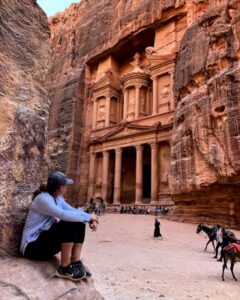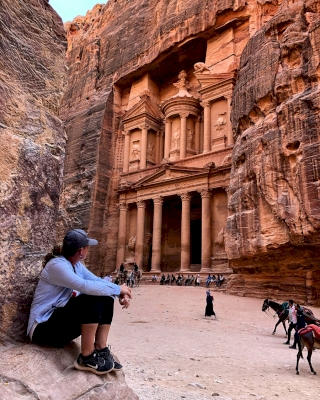Petra, Jordan, often referred to as the “Rose City” due to the hue of its stone, is a UNESCO World Heritage site renowned for its breathtaking rock-cut tombs. Built by the Nabataean civilization over 2,000 years ago, these architectural wonders are a testament to the ancient city’s wealth, cultural influence, and craftsmanship.
Today, Petra’s tombs, such as Al-Khazneh (The Treasury) and the Royal Tombs, stand as magnificent examples of Nabataean ingenuity, blending Hellenistic and local styles.
Al-Khazneh (The Treasury): A Symbol of Nabataean Splendor
The Iconic Al-Khazneh
Al-Khazneh, also known as The Treasury, is Petra’s most famous tomb and arguably the face of the ancient city. Carved directly into the rose-red cliffs, Al-Khazneh is believed to have been a royal tomb, though its exact purpose remains debated among historians.
Its grand facade, standing at 40 meters tall, showcases intricate carvings and Hellenistic architectural elements, reflecting the Nabataeans’ ability to merge regional and foreign influences.
The Treasury’s iconic appearance in modern media, particularly in films, has further cemented its status as one of the world’s most awe-inspiring ancient structures.
The Royal Tombs of Petra: An Architectural Masterpiece
The Urn Tomb
The Urn Tomb, one of the Royal Tombs in Petra, is another stunning example of Nabataean craftsmanship. Situated on the “Royal Tombs” trail, it is believed to have been constructed around 70 AD.
The tomb earned its name from the large urn placed at the top of its facade. The structure is remarkable for its monumental scale, featuring a large open courtyard and a two-story facade, typical of Nabataean monumental tombs.
The Silk Tomb
Another prominent tomb in Petra is the Silk Tomb, named for the swirls of pink, yellow, and white in the stone that give the facade a silk-like appearance.
Although smaller in scale than Al-Khazneh or the Urn Tomb, the Silk Tomb’s striking natural colors make it a popular attraction for visitors. Its simple, yet elegant facade highlights the Nabataeans’ ability to harness the natural beauty of Petra’s unique sandstone.
Nabataean Culture: Blending Styles and Influences
Hellenistic and Local Styles
The tombs of Petra are not just impressive due to their scale, but also for the unique blend of Hellenistic and local Nabataean architectural styles.
This fusion reflects the city’s role as a hub of trade and cultural exchange in the ancient world. The intricate detailing on the tomb facades, including floral and geometric patterns, showcases how the Nabataeans adopted and adapted influences from the Greek, Roman, and Egyptian cultures.
Craftsmanship and Wealth
The grandeur of these tombs also speaks to the wealth of the Nabataean civilization, which controlled trade routes and had access to luxury goods.
Petra’s status as a major center of commerce allowed the Nabataeans to fund the construction of these monumental tombs, symbolizing both their power and artistic achievements.
The Modern Significance of Petra’s Tombs
Tourism and Preservation Efforts
Today, Petra’s tombs are not just historical relics but key attractions that draw millions of tourists annually. Petra is one of the most visited archaeological sites in the world, and its tombs remain the focal points of visitor exploration.
Preservation efforts led by Jordan’s Department of Antiquities and international organizations have been crucial in maintaining these structures amid threats from erosion and tourism impacts.
Cultural and Historical Importance
For Jordan, Petra and its tombs are symbols of national pride and cultural heritage. The city’s inclusion in the New Seven Wonders of the World in 2007 further elevated its global status.
Petra’s tombs offer invaluable insights into the history and achievements of the Nabataean civilization, making it a key site for archaeologists and historians studying ancient Middle Eastern cultures.











